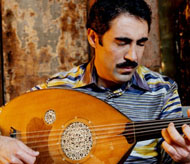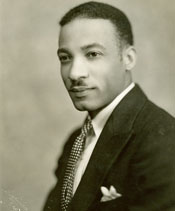 Program Notes
Buy Tickets
[divider_flat][box style=”rounded” border=”full”]
Program Notes
Buy Tickets
[divider_flat][box style=”rounded” border=”full”]
Political Awakenings features music that reflects the history and beauty of two distinct cultures around the globe and across generations that are united by a common struggle for human dignity. From the African-American experience of slavery and the battle for Civil Rights to the more recent cries for freedom and justice of the Arab Spring, the composers and performers here capture the spirit of their people.
[/box] [divider_flat][divider_flat] [twocol_one]THE ARTISTS
Mei-Ann Chen, Music Director and conductor
 Political Awakenings continues Mei-Ann Chen’s second season as Chicago Sinfonietta Music Director. In her short time with the orchestra, she has earned two awards from the League of American Orchestra: The Helen M. Thompson Award, given to a music director every two years to recognize their impact and potential for a significant national career, and one for the orchestra, a First Place Award for Adventurous Programming.
Political Awakenings continues Mei-Ann Chen’s second season as Chicago Sinfonietta Music Director. In her short time with the orchestra, she has earned two awards from the League of American Orchestra: The Helen M. Thompson Award, given to a music director every two years to recognize their impact and potential for a significant national career, and one for the orchestra, a First Place Award for Adventurous Programming.
As the Sun-Times’ Andrew Patner has remarked, “Mei-Ann Chen… was born to lead this group. She plays and speaks from the heart, the body and the head, and the audience and players have embraced her.”
Born in Taiwan, Ms. Chen has lived in the United States since 1989. She holds a Doctor of Musical Arts degree in conducting from the University of Michigan, where she was a student of Kenneth Kiesler. Prior to that, she was the first student in New England Conservatory’s history to receive master’s degrees, simultaneously, in both violin and conducting. She is also the Music Director of the Memphis Symphony Orchestra and is in high demand around the globe as a guest conductor.
Mei-Ann Chen’s complete biography can be found here.
[/twocol_one] [twocol_one_last]
Maestro Chen shares her thoughts on Political Awakenings in this video clip
Simon Shaheen, Oud
 Simon Shaheen is a Palestinian-American composer and a virtuoso of the violin and oud, a Middle Eastern string instrument that is a predecessor of the guitar. He began playing the oud at age four. Under the tutelage of his father, Hikmet Shaheen, a renowned teacher and composer of Arabic music, Simon performed his first public improvisation at age six. Shaheen studied Western classical violin at the Rubin Conservatory and went on to Tel Aviv, where he earned a B.A. in music and Arabic literature. He moved to the United States to complete an M.A. in Music Education from Columbia University and an M.A. in Music Performance from the Manhattan School of Music. He heads a music program at Berklee College of Music in Boston, and is a highly regarded master of traditional Arabic music. His own works often fuse that tradition with Western classical arrangements and touches of jazz and pop. “I want to create a world music exceptionally satisfying to the ear and for the soul,” says Shaheen.
Simon Shaheen is a Palestinian-American composer and a virtuoso of the violin and oud, a Middle Eastern string instrument that is a predecessor of the guitar. He began playing the oud at age four. Under the tutelage of his father, Hikmet Shaheen, a renowned teacher and composer of Arabic music, Simon performed his first public improvisation at age six. Shaheen studied Western classical violin at the Rubin Conservatory and went on to Tel Aviv, where he earned a B.A. in music and Arabic literature. He moved to the United States to complete an M.A. in Music Education from Columbia University and an M.A. in Music Performance from the Manhattan School of Music. He heads a music program at Berklee College of Music in Boston, and is a highly regarded master of traditional Arabic music. His own works often fuse that tradition with Western classical arrangements and touches of jazz and pop. “I want to create a world music exceptionally satisfying to the ear and for the soul,” says Shaheen.
He has performed extensively throughout the U.S., Europe and Middle East with his multiple ensembles (Qantara, Quintet, the Near Eastern Music Ensemble and Arab Orchestra) plus appearances with Quincy Jones, Sting, Dave Brubeck and the Detroit Symphony. He is the recipient of several honors including the National Heritage Award and the United Nations Outstanding Artistic Contribution Award.
A good overview of Shaheen’s career and music, along with several sound samples, is at the All Music website.
[/twocol_one] [twocol_one_last]
Simon Shaheen shows his mastery of the oud in this simple performance video
THE COMPOSERS
Wolfgang Amadeus Mozart
Abduction from the Seraglio (overture)
 “Too many notes. Just cut a few and it will be perfect.” According to the film Amadeus, this is the advice given to Mozart by Viennese Emperor Joseph II, who commissioned Abduction from the Seraglio. Fortunately, Mozart was not in the habit of accepting composition tips from others. His reply is said to have been, “’There are just as many notes as there should be.”
“Too many notes. Just cut a few and it will be perfect.” According to the film Amadeus, this is the advice given to Mozart by Viennese Emperor Joseph II, who commissioned Abduction from the Seraglio. Fortunately, Mozart was not in the habit of accepting composition tips from others. His reply is said to have been, “’There are just as many notes as there should be.”
Anything Turkish was in style at that time, and true to the trend, Mozart sets Abduction in a Turkish harem and flavors the music with extra percussion, evoking the military Janissary bands of Turkey, especially in the rollicking overture. But Abduction was far more than just trendy and Turkish. The depth of Mozart’s music was constantly increasing during this period. The work is lighthearted and frequently comic, yet extremely complex (as might be gleaned from the Emperor’s critique). Abduction is the story of two men rescuing their lovers from a Pasha’s harem, but the way Mozart blends high comedy with touching tragedy signals his new maturity as an opera composer. Thus, in both form (a Westernized take on Turkish music) and story (a tale of liberation) it makes for a perfect beginning to this concert.
This Encyclopedia Britannica biography is exhaustive. A more detailed look at Seraglio can be found in this Wikipedia entry.
[/twocol_one] [twocol_one_last]
The video is a performance of the Overture by an orchestra from the city of its birth, the Vienna Symphony Orchestra
Simon Shaheen
Oud Concerto in C Minor
 The Oud Concerto in C Minor is a three movement work that received its premiere in 2008 as a commission of the Detroit Symphony Orchestra. It has since been performed around the globe as well as a second performance in Detroit, which has one of the largest Arab populations outside of the Middle East. The Sinfonietta performance is its Chicago premiere.
The Oud Concerto in C Minor is a three movement work that received its premiere in 2008 as a commission of the Detroit Symphony Orchestra. It has since been performed around the globe as well as a second performance in Detroit, which has one of the largest Arab populations outside of the Middle East. The Sinfonietta performance is its Chicago premiere.
“Since I am versed in both Arabic and Western classical styles,” Shaheen says, referring to the concerto. “I worked on bridging the sounds with the oud and the orchestra. I used some of the Arabic music scales and rhythmic modes so that the orchestra doesn’t sound like the typically Western classical harmony, but has certain colors and textures.”
[/twocol_one] [twocol_one_last]
Here is a portion of the second movement from the Athens performance of the Oud Concerto
William Levi Dawson
Negro Folk Symphony
 William Levi Dawson (1899-1990) was a noted African American composer and professor of music at the Tuskegee Institute. He attended Tuskegee as a young man, then went on to earn a Masters Degree at the American Conservatory of Music in Chicago, where he was also first trombone with the Civic Orchestra. He returned to Tuskegee as a teacher and choir director in 1931.
William Levi Dawson (1899-1990) was a noted African American composer and professor of music at the Tuskegee Institute. He attended Tuskegee as a young man, then went on to earn a Masters Degree at the American Conservatory of Music in Chicago, where he was also first trombone with the Civic Orchestra. He returned to Tuskegee as a teacher and choir director in 1931.
Dawson began work on the Negro Folk Symphony when he was still in Chicago. While on tour with the Tuskegee choir in New York, he showed the manuscript to the Leopold Stokowski, who made suggestions for its expansion. It was first performed by the Philadelphia Orchestra in 1934. The critic for the New York World Telegram praised the symphony’s “imagination, warmth, drama… [and] sumptuous orchestration”. In its overall shape, and especially in its orchestration, the symphony falls into the late-Romantic tradition. After a trip to West Africa in 1952, the composer revised it to embody authentic African rhythmic patterns. It was in this form that Stokowski recorded it in 1963, and is most frequently played today.
Dawson himself said this about the work: “This Symphony is based entirely on Negro folk music. The themes are taken from what are popularly known as Negro spirituals, and the practiced ear will recognize the recurrence of characteristic themes throughout the composition.”
Dawson’s Wikipedia entry has more information about his life, career, and honors.
[/twocol_one] [twocol_one_last]
The video clip contains a portion of the Symphony’s first movement, “The Bond of Africa”.
Learn more about the music directly from the source at Prelude, an artist discussion series that takes place on stage one hour prior to the concert at both Harris Theater and Wentz Concert Hall. Our guest in April will be Simon Shaheen.
[/box]
